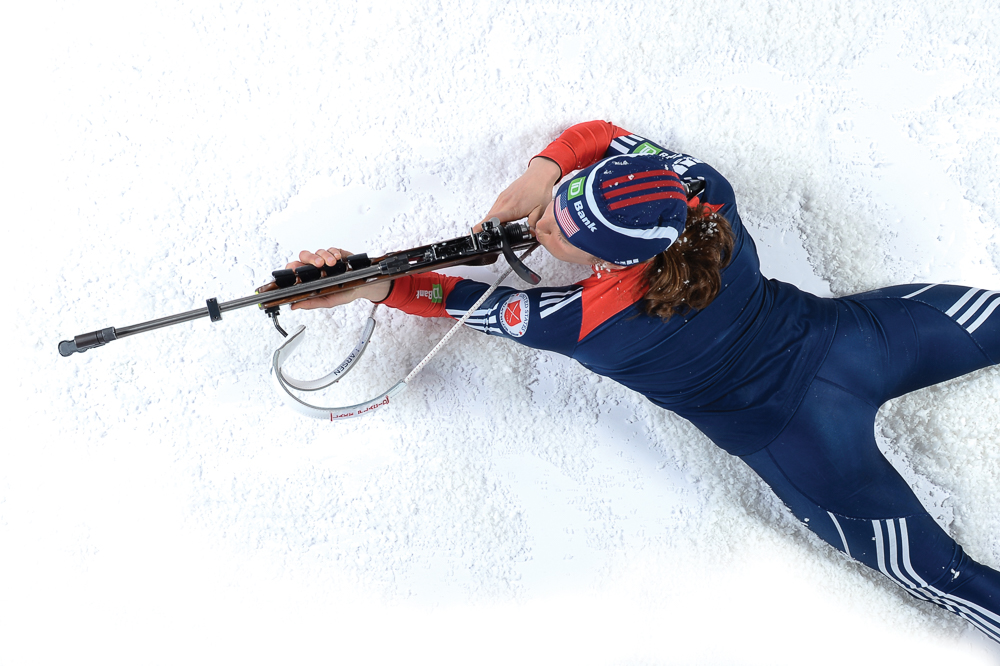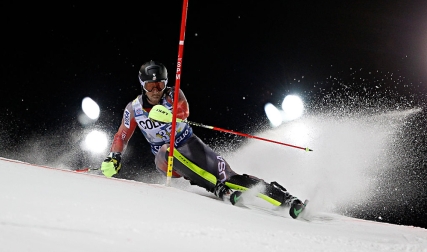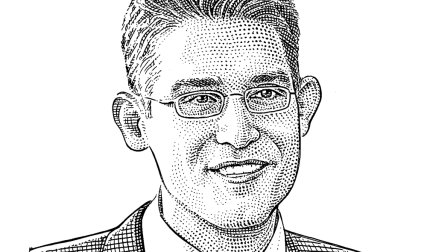Coming into the stadium somewhere in the middle of a pack of 30 female skiers, Susan Dunklee tries to clear her mind of everything—to forget, for a moment, about the 40,000 screaming fans, and that she’s going for a medal in the world championships in biathlon and, above all, the possibility that she might miss a shot and have to ski a “penalty loop,” which will likely knock her out of contention.
Combining cross-country ski racing and target shooting, biathlon is the most popular televised winter sport in Europe and Russia. In the United States? Not so much, despite our penchant for firearms. That could be changing: Just one day earlier, Dunklee’s teammate, Lowell Bailey, had sprinted to America’s first-ever gold medal at these world championships in Hochfilzen, Austria. Now, Dunklee realizes, it could be her turn.
She focuses her thoughts on the first of four key words that she hopes will help her shoot down five small targets, a difficult accomplishment in the middle of an intense cross-country ski race, when her heart rate is somewhere around 180 and her lungs are heaving. The next few seconds will determine whether she stays with the leaders or drops to the back of the pack.
OPEN: Dunklee reaches back and flips open the metal flap covering the sights of her .22-caliber target rifle, which she carries on her back. She checks the wind flags and finds her shooting station, drawing a deep breath to fill her lungs with precious oxygen.
RELAX: Diving down into a prone position at the station, skis splayed, she props herself on her left elbow, pointing the gun downrange and whooshing out a big breath, hoping to quiet her thoughts and calm her body, which feels like it is on fire because she’s just skied 2.5 kilometers at race pace with the best athletes in the world.
SET: Quickly but carefully, she pops in the five-shot magazine, clicks the bolt home and puts her eye to the gunsight, searching for the small black targets 50 meters downrange, each the size of an Oreo.
STILL: She goes motionless. At the right moment, her trigger finger moves imperceptibly and the gun fires. The first target goes down. She fires four more times in rapid succession, hitting all her targets, and when she exits the stadium for her second lap, she is in the lead.
Biathlon wasn’t even on Dunklee’s radar when Dartmouth recruited her as a cross-country runner.
The front of the pack in a world championship biathlon race is, for an American athlete, a strange and bewildering place to be. Yet Dunklee had been preparing for that moment last February since before her college graduation.
The sport was invented by Norwegian border guards in the 1700s, and since then it has been dominated by Scandinavians, along with Russian and German athletes. Before 2017, only two Americans had ever won a medal at a world championship. Our Olympic biathlon medal count stands at exactly zero.
That could be changing. Thanks to Bailey’s world championship medal and Dunklee’s increasingly strong performances on the World Cup circuit, where she is ranked in the top 10, both American athletes are heading to Pyeongchang as medal contenders. “Susan is the best American female biathlete probably ever,” says U.S. Biathlon Association CEO Max Cobb ’87.
Biathlon wasn’t even on Dunklee’s radar when Dartmouth recruited her as a cross-country runner. She’d excelled at running at St. Johnsbury Academy, the small private school she attended in northern Vermont. But Dunklee also excelled at Nordic skiing, and she liked it even more, helping lead Dartmouth to a team title at the NCAA championships in 2007.
This was no surprise: Both her parents, Stan and Judith Dunklee, had been top cross-country skiers for the University of Vermont, and her father had been an Olympic teammate and friend of Bill Koch, whose 1976 silver medal remains the first and last cross-country skiing Olympic medal ever won by an American. “Having a parent who was an Olympian means, yeah, you might have some fairly good genes,” says Dunklee, “but it’s also important just having somebody in your life who is a role model for believing that sort of achievement is possible. It just seems so much more real.”
When she wasn’t ski racing at Dartmouth, Dunklee was often seen riding a unicycle around campus—her bike broke, she explains, and a unicycle was just simpler. A pragmatic thinker who began her college career as an engineer, she’s good at drilling down to the essence of a problem and solving it. That’s also been her approach to biathlon.
In March of 2008, the U.S. Biathlon Association invited her to apply for a training program designed to turn top NCAA skiers into biathletes. She was ambivalent at first. Part of her wanted to put her biology degree to use, get a job and get on with adult life. A conversation with her dad changed her mind. “He said, ‘You know what, Susan, if you don’t try this, you’re always going to wonder what if?’ ” she says. “He knows me better than anyone in that way.”
Dunklee moved to the Olympic training center in Lake Placid, New York, and started learning how to combine skiing with a new discipline, shooting. She loved the new sport almost immediately, in part because it had an extra dimension that pure skiing lacked. “You can finish in third one day and 80th the next because of the shooting,” she says. “It’s so unpredictable. It keeps you hungry and it fires you up.”
But even her own teammates had doubts that Dunklee could combine the intensity of racing with the focus required to shoot well. “Her racing style had always been to go as hard as she possibly could,” says Dartmouth skiing teammate Chelsea Little ’09, who writes about biathlon for FasterSkier. “Imagining her on a shooting range was like, oh, that’s not gonna work. She can’t slow down enough!”
But in fact, Dunklee had the opposite problem: When she came onto the shooting range she was too slow, losing valuable seconds to the other women. When she got back onto the course, she’d find herself playing catch up. After a string of should’ve-could’ve finishes in 2014 and 2015, including a near miss at medaling in the 2014 Olympics in Sochi, she resolved to fix the problem. As it turned out, part of the solution involved bees.

In late October, as Dunklee was preparing to leave for a preseason training camp in Canada, she went to pay one last visit to her bees. They live in two tall hives set off behind some cabins at the Craftsbury Outdoor Center in northeastern Vermont, not far from where Dunklee grew up. An electric fence surrounds the hives to keep out hungry bears.
Soon the bees would be hunkering down for the winter, even as Dunklee’s own life would be ramping up. She would be on the road until just before Easter, traveling to training camps and then World Cup races all around Europe, plus three weeks for the Olympic Games in South Korea, halfway around the world.
Craftsbury has been home for six of the last seven years. During that time Dunklee has been part of something called the Green Racing Project, a group of Olympic hopefuls in skiing, rowing and biathlon who receive room and board and training facilities in exchange for performing odd jobs and coaching junior athletes at the center, which is owned by Dick Dreissigacker and Judy Geer ’75, founders of the Concept2 rowing-machine company. Just this morning the promising biathlete was out doing race-pace intervals on roller skis with biathlon teammate Emily Dreissigacker ’11 (a daughter of Dick and Judy) and U.S. ski team member Ida Sargent ’11, who are also Olympic hopefuls. “We’ve been skiing together here since we were little kids,” Dunklee says. “It’s kind of nice.”
She keeps the bees because she thinks they’re cool, but also because she knows them well. In her ecology studies at Dartmouth she specialized in pollinator systems and spent summers doing research on bees in the Rocky Mountains. She considers the beekeeping an important part of her training, helping her develop the mental focus and calm under pressure that she needs to succeed in biathlon, which requires athletes to go from full-gas ski racing down to the stillness of target shooting in a matter of seconds.
She considers the beekeeping an important part of her training, helping her develop the mental focus and calm under pressure that she needs to succeed in biathlon, which requires athletes to go from full-gas ski racing down to the stillness of target shooting in a matter of seconds.
“If you’re trying to inspect the hive and see what’s going on, the second you start to fear, they sense it—so you have to stay super focused,” Dunklee says. “You can’t make sudden movements, you can’t bump the hive and piss them off. It reminds me a lot of shooting in a high-pressure race situation.”
Shooting in a biathlon race is a lot harder than it looks, as I realized during my visit to Vermont in October. When we had finished talking in the newly rebuilt Craftsbury lodge, Dunklee got her gun out of the back of her blue Honda Fit, and we walked over to the shooting range for a demonstration. (Her car also contained a half-dozen planks and a book on how to build your own wooden canoe.)
The gun is a thing of beauty, a .22-caliber Anschutz precision target rifle with a walnut stock that she’s customized to her own dimensions. Her fingers fit exactly into the grooves in its base. (Price: $3,590.) Dunklee loaded a clip with five bullets, showed me how to sight it, and I lay down to shoot. I hit five out of five targets—“cleaning,” in biathlon lingo. She put in another clip, and I tried again, this time from a standing position (biathlon races usually require a mix of prone and standing shots). This time it was harder to train the sights on the small black target, and I hit only two of five.
“Now go run around the field a few times,” Dunklee ordered, and off I went. A couple of minutes later she handed me the rifle and I dropped down into the prone position. Forget about it: My lungs heaving, shoulders aching, I could barely hold the gun level. I missed five out of five. Each missed shot means you ski an extra penalty loop and, in all likelihood, puts you further out of contention. I’d earned myself five extra loops.
Dunklee took her rifle from me. “Looks like you’re going skiing,” she said.
When the skiers leave the shooting range for their third lap of four, back at Hochfilzen, Dunklee is still a handful of seconds ahead of a chase group that has dwindled from 10 skiers to five to three. As the only one without a World Cup or world championship win, she is the clear underdog. “There are one or two nervous bookies watching right now,” quips a TV commentator.
But to Dunklee, being in the lead is not an accident. She’d been rising steadily in the rankings, pulling off top-10 and then top-five finishes, reaching the podium for the first time in 2014. In the Sochi Olympics that season, she was in medal position in a race when she barely missed her final shot. The 30-second penalty loop dropped her from a likely second or third place to 14th. “She was millimeters away from winning a silver medal,” says Cobb.
Since Sochi, Dunklee has focused as much on her shooting as on her skiing—and not only her accuracy, but her speed. “I was losing 15 seconds or more to people in the shooting stage,” she told me at Craftsbury. “That’s like two-thirds of a penalty loop.” That required her to ski hard just to catch up to the leaders. “So I said, I am sick and tired of this! And I want to fix it.”
Working with Sean McCann, a sport psychologist with the U.S. Olympic team, she broke down the whole process of coming into the range, getting into position, sighting, and shooting into four discrete segments, each signified by one of Dunklee’s keywords: Open. Relax. Set. Still.
The results were dramatic. Not only did her speed improve dramatically, so did her accuracy. “She took herself from probably the slowest athlete on the range to the fastest,” says Cobb.
And now, at Hochfilzen, it is all coming together. When they come into the shooting range for the fourth and final time, this time from a standing position, it’s down to Dunklee and three other women. She cleans it yet again, hitting all five targets perfectly. Two competitors miss a shot, meaning they’re out. Only one racer is left to chase Dunklee: Laura Dahlmeier of Germany, perhaps the sport’s most dominant woman.
Dunklee leaves with a five-second lead, Dahlmeier in pursuit, as 40,000 mostly German-speaking fans bellow and scream. As the pair charges up the biggest hill on the course, Dahlmeier passes Dunklee and gets a 20-yard gap that the American can’t close. Helplessly, she watches the German ski away from her.
“I was in survival mode, I had so little energy left,” Dunklee tells me later. She hangs on for second place, a historic finish, and as she crosses the line she throws both arms in the air in a jubilant salute. Even though she didn’t win, it’s still a victory.
Bill Gifford is a freelance writer. He lives in Park City, Utah.




